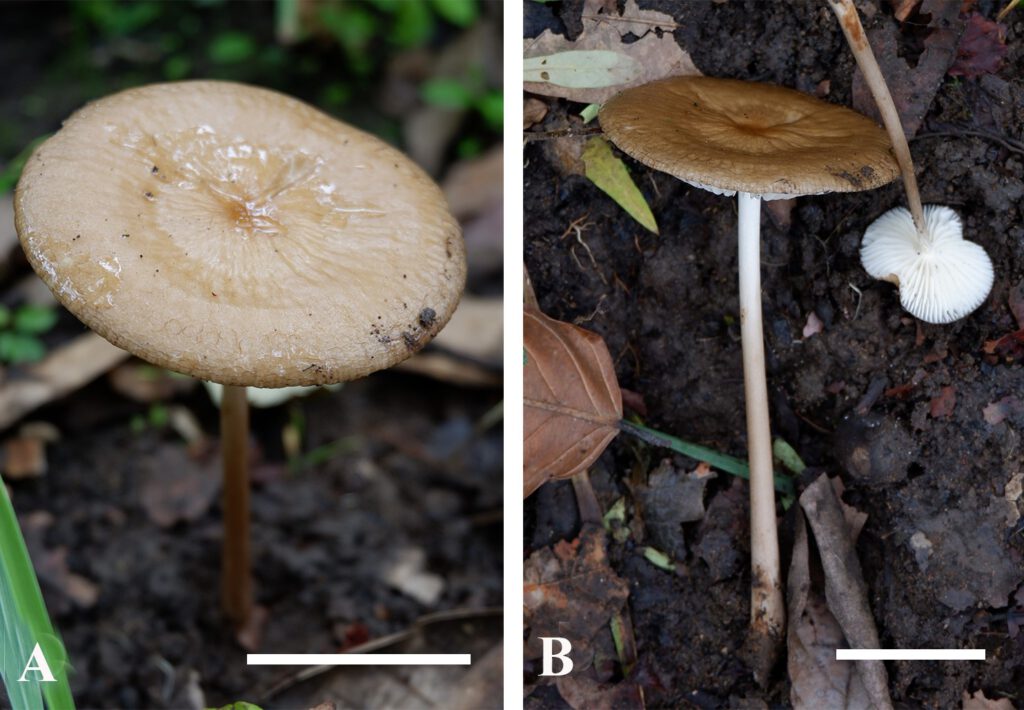Hymenopellis utriformis Niego, & Raspé, sp. nov. (Fig. 4-5)
MycoBank number: MB 845751; Index Fungorum number: IF 845751; Facesoffungi number: FoF 12895;
Type:—THAILAND. Chiang Mai Province: Mae Taeng, elevation 397 m, tropical deciduous forest, 09 August 2019, A.G. Niego, MFLU22-0140 (holotype); GenBank OP265164-ITS, OP265159-nrLSU
Etymology:—The name came from the most common utriform and narrowly utriform pleurocystidia.
Description:— Basidiomata small-sized to large. Pileus 25–95 mm diam., circular in polar view, in side view broadly convex to plane to slightly depressed, light brown (5C5), moist to viscid, non-hygrophanous, rugose surface, radially wrinkled with age; margin plane to decurved, translucent striate; context cream (1A3) to white, unchanging when cut, consistency rubber-like. Lamellae 4–8mm width, attachment adnexed, ventricose, white to cream (1A3), spacing greater than 1mm apart; lamellar margin even; lamellulae present, in two tiers. Stipe 50–185 mm × 4–12 mm, central, cylindrical, mostly equal, thickened at the base, off-white to light brown (5A2) from the pileus becomes darker (5D4) towards the base, surface dry, appressed squamulose especially towards the base, narrowly fisutlose; context white, unchanging when cut; pseudorrhiza present. Annulus and volva absent. Spore print white. Smell indistinct. Taste slightly sweet.
Basidiospores [60,3,1] (11.7) 12–13.7– 16.7 (17) × (9.3) 10.1–11.4–12.6 (12.7) µm (Q = 1.0–1.5, Q* = 1.2), subglobose to ellipsoid, thin-walled, hyaline in 5% KOH. Basidia [30,3,1] (36) 36.7–38.1–39.2 (39.5) × (9.4) 11.3–11.6–12.8 (13) µm (Q = 3.0–4.0, Q* = 3.3), 2–spored, clavate, without clamp connection. Cheilocystidia [30,3,1] (31) 38–52–64 (67.7) x (8.6) 9–13.2–18 (18.5) µm (Q = 3.1–5.0, Q* = 3.9), numerous, grouped together, pedunculate, narrowly clavate to clavate, conical, narrowly utriform to utriform, smooth, thin-walled, hyaline in 5% KOH. Pleurocystidia [30,3,1] (83) 88–116.3–131 (174) × (22) 22.5–30–35 (37.5) µm (Q = 2.9–5.4, Q* = 3.9) scattered, narrowly utriform to utriform, smooth, thin-walled, hyaline in 5% KOH. Hymenophoral trama irregular, made of thin-walled, hyaline hyphae. Pileipellis an epithelioid hymeniderm, terminal elements 28–52–76 × 11–13.7–17.5 µm with few scattered intracellular light brown (6D8) pigment in 5% KOH. Stipitipellis a trichoderm, terminal elements 28–52–76 × 11–13.7–17.5 µm, with intracellular light brown (6D8) pigment in 5% KOH. Clamp connections not seen.
Habitat and distribution:—Solitary or cluster, three basidiomata near each other growing in soil covered with degrading leaves and other organic matters in the deciduous forest of Chiang Mai Province, Thailand. Around 100 m away another basidioma growing alone in soil.
Additional specimen examined:— THAILAND. Chiang Mai Province: Mae Taeng, altitude 373 m, tropical deciduous forest, 09 August 2019, A.G. Niego, MFLU22-0141; GenBank OP265165-ITS, OP265160-nrLSU
Note:—Hymenopellis utriformis is similar to Hymenopellis rubrobrunnescens (Redhead, Ginns & Shoemaker) R.H. Petersen, having small to large but gracile basidiomata. The color is “tawny olive” 5C5 with rugose to rugulose surface.
Hymenopellis radicata (Relhan) R.H. Petersen as described by Petersen and Hughes (2010) is similar to H. utriformis, having large basidiomata and a mid-brown (5–6D, 5–6E5–8, 5E7, 4E7, 6D3) pileus which is radially wrinkled. Both species are rather moist to viscid. However, H. radicata’s stipe is longitudinally lined, usually twisted. Cheilocystidia of H. radicata are clavate to subcapitulate when young, broadly cylindrical, jar-shaped to occasionally mammilate when mature, whereas that of H. utriformis were more diverse in shapes. Pleurocystidia of H. radicata are strongly inflated, bluntly rounded to hemispherical apically, narrowly utriform to utriform while H. utriformis have narrowly utriform to utriform pleurocystidia only.
Other species similar to H. utriformis found in Asia are H. furfuracea and H. raphanipes having medium to large basidiomata but with more diverse pileal colors (Petersen and Hughes 2010). Hymenopellis furfuracea are tetrasporic while Hymenopellis raphanipes can be 2–spored except for the synonymized H. chiangmaiae, which is the tetrasporic from Asia. Hymenopellis utriformis, however, is strictly 2–spored.

Figure 1. A–B basidiomata of Hymenopellis utriformis HT19-0055. Photographs by A.G. Niego.

Figure 2. A basidiospores B basidia C cheilocyctidia D pleurocystidia E pileipellis F caulocystidia
